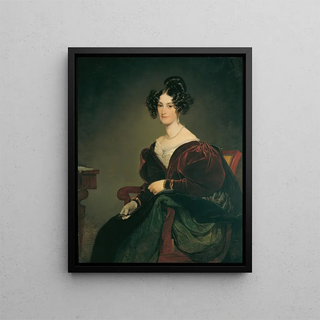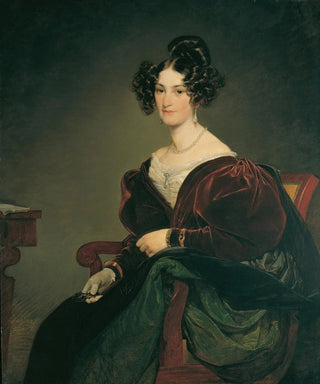Art print | Amalie Klein - Friedrich von Amerling


View from behind

Frame (optional)
In the vast panorama of art history, certain works stand out for their ability to capture the essence of the era in which they were created. "Amalie Klein - Friedrich von Amerling" is one of those iconic pieces that, through its elegance and finesse, transports us to the mid-19th century. This portrait, highlighting the beauty and grace of Amalie Klein, embodies not only a moment in artistic history but also a reflection on the female condition and the role of women in society at the time. Through this painting, Friedrich von Amerling, a master of portraiture, manages to convey a psychological depth that still resonates today.
Style and uniqueness of the work
The piece is distinguished by its realistic style, characteristic of Amerling's approach, which excels in depicting textures and details. The brightness of the colors, combined with a delicate painting technique, brings the canvas to life, making Amalie Klein's face strikingly intense. The composition is carefully orchestrated, with each element in its place to create visual harmony. The artist succeeds in capturing not only the physical appearance of his model but also a certain aura of mystery that prompts the viewer to question Amalie's personality. This portrait goes beyond simple representation; it is an invitation to explore the thoughts and emotions of the depicted figure.
The artist and his influence
Friedrich von Amerling, born in 1803 in Vienna, is one of the most renowned portraitists of his time. His work is marked by meticulous attention to detail and a capacity to render human expressions with rare precision. Influenced by the Romantic movement, Amerling is distinguished by his desire to portray his subjects in all their complexity. His portraits, often imbued with a certain melancholy, testify to a particular sensitivity to human psychology. By choosing Amalie Klein as a model, Amerling not only pays homage to her beauty but also immortalizes an era when women began to claim their place in society. His influence endures, inspiring many contemporary artists seeking to explore the nuances of identity.

Matte finish

View from behind

Frame (optional)
In the vast panorama of art history, certain works stand out for their ability to capture the essence of the era in which they were created. "Amalie Klein - Friedrich von Amerling" is one of those iconic pieces that, through its elegance and finesse, transports us to the mid-19th century. This portrait, highlighting the beauty and grace of Amalie Klein, embodies not only a moment in artistic history but also a reflection on the female condition and the role of women in society at the time. Through this painting, Friedrich von Amerling, a master of portraiture, manages to convey a psychological depth that still resonates today.
Style and uniqueness of the work
The piece is distinguished by its realistic style, characteristic of Amerling's approach, which excels in depicting textures and details. The brightness of the colors, combined with a delicate painting technique, brings the canvas to life, making Amalie Klein's face strikingly intense. The composition is carefully orchestrated, with each element in its place to create visual harmony. The artist succeeds in capturing not only the physical appearance of his model but also a certain aura of mystery that prompts the viewer to question Amalie's personality. This portrait goes beyond simple representation; it is an invitation to explore the thoughts and emotions of the depicted figure.
The artist and his influence
Friedrich von Amerling, born in 1803 in Vienna, is one of the most renowned portraitists of his time. His work is marked by meticulous attention to detail and a capacity to render human expressions with rare precision. Influenced by the Romantic movement, Amerling is distinguished by his desire to portray his subjects in all their complexity. His portraits, often imbued with a certain melancholy, testify to a particular sensitivity to human psychology. By choosing Amalie Klein as a model, Amerling not only pays homage to her beauty but also immortalizes an era when women began to claim their place in society. His influence endures, inspiring many contemporary artists seeking to explore the nuances of identity.






